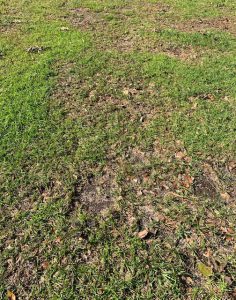Many North Florida lawns are not looking too good this spring. Some lawns are weak and some have dead areas that used to be alive and green. Unfortunately, this is relatively common.
Not being satisfied with the appearance of their lawn, many homeowners make matters worse by fertilizing too early.
Sometimes, they are fertilizing already dead lawn grass.

All of our lawn grasses respond to daylength and temperature in order to resume growth in spring. The correct daylength happens first, slowly followed by the correct soil temperature.
Most lawns in our area will begin to resume top growth (new green leaves) sometime in March, triggered by the correct daylength. However, the second trigger (warm soil) lags behind. It takes consistently warm nights to allow the root area (soil) to sufficiently warm to allow optimal root growth and subsequently efficient uptake of fertilizer. Most years, it’s not until mid-April or May before the soil warms up enough to allow the lawn roots to regrow and to efficiently take up the fertilizer. As a result, it’s best to wait until at least mid-April before applying any fertilizer to a North Florida lawn.
Fertilizing too soon, in February or March, can force new growth too soon only for that new, tender growth caused by early fertilization to be injured by the predictable last killing frost of mid-March. This weakens the lawn even more. In addition, fertilizing before the root area (soil) is sufficiently warm, results in the fertilizer quickly leaching. And, fertilizer elements such as iron and potassium remain poorly available to lawn roots under cool soil conditions. Finally, during the transition from winter to spring, the lawn is attempting to grow a new root system. Theses young, tender roots are easily burned by early fertilizer applications.
Regardless of the cause, weak, declining areas within lawns are slow to recover in spring.
Cool soil temperatures don’t allow rapid root regeneration in spring. Consistently warmer nights allow soil temperatures to warm, which will improve turf root growth, nutrient availability and lawn recovery. But this is a gradual process, not a quick recovery.
If your lawn has not made significant improvement by late spring or early summer, it may be time to consider replanting those dead, declining areas. And, take time to learn how to correctly manage a Florida lawn. But whatever you do, don’t continue to follow lawn maintenance practices that do not work in Florida and that contribute to your lawn’s demise.
Here is a link to a UF/IFAS Extension publication on Best Management Practices for a Florida lawn. Call (850) 689-5850 to have a copy mailed to you.
http://edis.ifas.ufl.edu/ep236
 0
0
